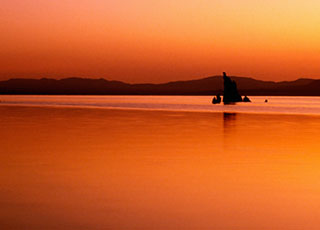
Mono Lake, California
To emphasize the concept of the peace and tranquility of this lake at dawn, the horizon was place near the center of the image. The predawn light of sunrise added a glowing warmth.
In one of my recent classes, I had a student who submitted some really interesting landscapes, but when I tried to evaluate and explain what I feel makes a landscape image good, there was some difficulty getting the message across to him. That brought up the question of what qualities does a landscape photograph have to have to make it really special, and how should a photographer approach a landscape? As always, when I’m troubled, have questions, or just need a bit of inspiration, I go back to the older books and some of the master photographers whose work I admire.
One of my treasured books is The Glory of Nature’s Form. It features the photography of Willis Peterson and was first printed by Beautiful America Publishing Company in Beaverton, Oregon, in 1979. As he explains his work, Peterson talks about seeing the essence of what’s there. In my own experience, it’s sometimes difficult to narrow down my vision–to distill what I have in front of me–into the essence of what’s there. When I’m driving along, I sometimes see something that makes me stop. I always photograph the first image I see, but time has shown me that the first image should be only the beginning of my exploration.
After I take my first image, the work begins. I try to identify exactly what it was about the scene that drew my attention. Then, I try to simplify it, so my images become exact. Was it the mood of the clouds that caused me to stop? Was it the golden leaves of the aspen forest? Was it the light reflecting on the lake? Once I can identify the essence of the scene and of the moment, then I can explore how to best photograph it.
As I investigate how to photograph my scene, I need to make a number of compositional decisions. Should I photograph from a higher angle or a lower one? Should I include the tree or cut it out of the image? Is there a repetition of pattern or shape? If I put a large shape there, should I balance it with another shape here? I’ve discovered a need to continually assess what’s being included in the image, how the elements of the composition are being arranged, and what can be omitted without the loss of that essential “ah-hah!” factor.
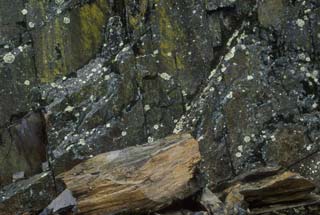
Rocks near the Merced River
Entrance to Yosemite NP, California
There are huge granite boulders along the Merced River on the western side of Yosemite. Because of the amount of rain, moss and lichen add to the texture of the rocks.
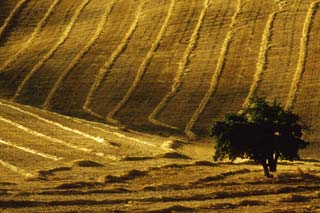
Livermore, California
One of the first parts of the scene that was intriguing to me was the lone tree in the middle of the field. Using that as an accent point, I incorporated it with the overall rows.
Another book in my collection is a brilliant book called Landscape Photography: the Art and Techniques of Eight Modern Masters (published in 1984 by Amphoto. In this book, photographers Franco Fontana, Yuan Li, Angelo Lomeo, Shinzo Maeda, Harald Sund, Sonja Bullaty, John Chang McCurdy and Steven C. Wilson share their thoughts on shooting landscapes.
Franco Fontana approaches his landscapes by viewing the scene as something that must be “sculpted” into his personal reality. While his approach is minimal, it isn’t abstract. Harold Sund looks for the drama in the landscape–the bolt of lightning or the glacier breaking up–the dynamic action of the moment. Yuan Li’s work is stark and simple in design and approach. Shinzo Maeda photographs the delicate and quiet beauty of Japan. Steven C. Wilson shows how man and animals live in the landscape. Sonja Bullaty captures the varying effects of climate, weather, and season in her landscape work, while her husband Angelo Lomeo includes a touch or sign of people who live on the land. John Chang McCurdy chooses the details in the landscape carefully and portrays a mysterious world of peace and serenity.
If I were to list the unique characteristics of their combined approaches, the list would look something like this: light, minimal, drama, simple, stark, delicate, quiet, details, variety, human presence, peace and serenity. Pulling out keywords that describe an image frequently helps define the essence of what we see and the essence of our approach.
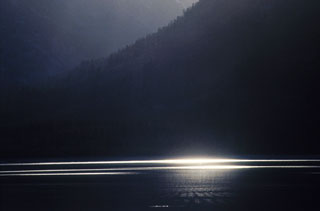
Jackson Lake
Grand Teton National Park, Wyoming
Being able to break down a scene into simple parts is not always easy but driving by this lake in the late afternoon I saw the light on the lake as it began to drop behind the mountains. For me, the light was the subject and I took my light reading from a light area just to the side of the brightest spot. I didn’t care how dark the rest of the image would be, but I wanted some detail in the light areas. By using your exposure controls effectively, you can also emphasize or de-emphasize parts of the image.
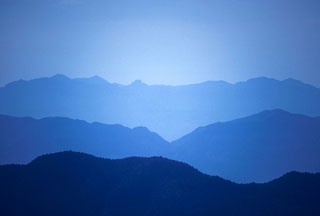
Inyo Mountains, California
Ridges of mountains are typical of the basin-and-range areas of California/Nevada high desert areas. Being aware of the vistas at the right time of day can give you interesting images of the repetition of color and pattern.
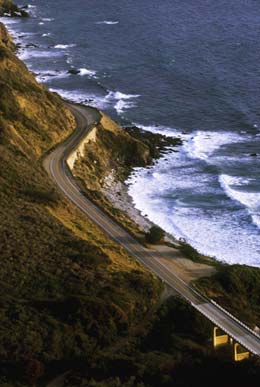
Highway 1 – along the California Coast
This is another example of a design element being used as a primary subject of the image. In this example, we emphasized the edge of the diagonal by including the surf. Your eye is drawn to the diagonal of the road because of the repetition of the diagonal of the surf.
In his book Mountain Light, Galen Rowell speaks about the edges of the land as being the most interesting feature–where water meets land or where meadow meets mountain. You have only to look at his work to find the edges of nature absolutely fascinating.
In contrast, in his book Portraits of Earth, Freeman Patterson looks to the great variety found in the natural world. In his discussion of each image in the book, he allows us to glimpse his view of the natural and graphic design found in nature. He shows us how he uses the contrast of light and dark, shapes and textures to express his love of nature. (Of the books listed here, I believe this one has been a wonderful “textbook” to many nature photographers.)
When I knew I wanted to explore landscapes in this article, I asked one of my former participants and fellow photographer Gary Anthes a few questions about his landscape work. (see examples of Gary’s outstanding images on his site). The following is the core of the one-on-one conversation we enjoyed:
NB: Gary, Is there anything special that you look for when you come into an area to photograph?
GA: Well, first, I do a lot of preparation. I read what other photographers as well as non-photographers have said about the place I’m visiting. And I know the times of the full moon, sunrise and sunset times, etc. I have a plan for every day, but I know that plans are to be broken. So plan, but be flexible.
NB: What is your basic approach?
GA: I’m not sure what you mean exactly. But, in general, I go to the best places but then seek out the lesser attractions. When I went to Arches National Park, for example, I didn’t even drive by Delicate Arch. Instead, I got some fabulous shots of Sand Dune Arch, one of the lesser known attractions, and some other cool stuff you won’t see on the post cards in the gift shop. Part of this is realizing I’ll never improve on the works from legends like Ansel Adams and Galen Rowell, and part of it is that I have become bored with the classic images. I tend to like more intimate scenes, something I call meso-scale photography.
NB: When looking over the images on your website, what strikes you the most about them? Let me have some thoughts about your landscape work.
GA: Hmmm…Good question! I can’t define excellence, but I know it when I see it. When I see one of my own photos that I REALLY like a lot, I like to play a little thought experiment. I look at it long and hard and ask myself, what exactly is good about this picture, and how can I do this more often? And, of course, how could it have been even better? This is an excellent exercise to do with other people’s photos as well. Also, this is personal, but I can clearly remember the circumstances in which I captured almost every image. So, it may be that my favorite photos are the ones that bring back the best memories.
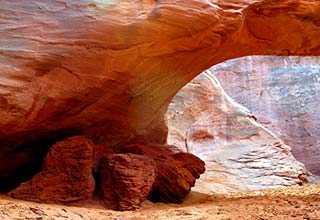
© Gary Anthes. All rights reserved.
Sand Dune Arch,
Arches National Park, Utah
I went here on a whim one morning, not knowing what to expect. I thought the colors and texture and light were just fabulous. I set up my camera and tripod but had to wait quite a while for this image, as the light kept changing and wild life (children) kept running in and out of the scene.
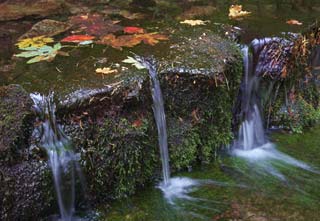
© Gary Anthes. All rights reserved.
Fern Spring,
Yosemite National Park, Calififornia
This is the overflow from a little spring, near the Pocono Bridge, that empties into the Merced River. I discovered it one morning while waiting for the sun to rise. The national parks have their blockbuster subjects, the kinds that appear on postcards, but I especially treasure these little vignettes.
NB: Anything you might like to add about landscape or nature photography?
GA: I was at an interesting photo show just yesterday. The judge had an obvious bias toward black-and-white images and toward anything that was unusual or off-beat. It’s sad when someone feels they have to “improve” on nature. Many of those photos wouldn’t have even been keepers for me. Why is different so often seen as better? What’s wrong with doing conventional photography but in an excellent way?
NB: Those are excellent questions, as well, and I don’t really have answers for you. One of the joys of photography is that there is room for many approaches and visions. But there are also common threads that can be found in each of the works of the masters.
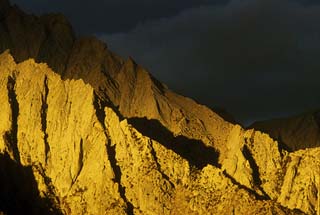
Lone Pine Peak, California
One of the areas that drew my attention the peaks in the Sierra Nevada Mountains was the side ridges of Lone Pine Peak. I waited until the light emphasized the diagonal of the land form. This is an example of how you can use a design element as the subject of an image.
What did I learn about landscape from the hours I spent with fascinating books and talking with Gary Anthes? In looking at the many beautiful images, I first saw flexibility in the viewpoints represented. There are many ways of looking and approaching the landscape.
My second question was what do these wonderful artists have in common? They took the complex and worked until the idea became simple. They narrowed the subject down to one dominant idea. They used the light effectively to emphasize. They contrasted a main subject with a smaller object to show size and scale. They emphasized shapes, textures, colors, and other basic elements of design to make their point. They photographed the common in uncommon ways and did it beautifully.
by Noella Ballenger
All text and photos unless otherwise stated: © Noella Ballenger. All Rights Reserved.

Leave a Reply